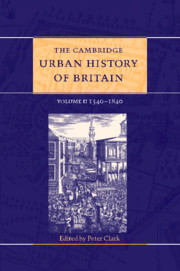Book contents
- Frontmatter
- 1 Introduction
- Part I Area surveys 1540–1840
- Introduction
- 2(a) England: East Anglia
- 2(b) England: South-East
- 2(c) England: South-West
- 2(d) England: Midlands
- 2(e) England: North
- 3 Wales
- 4 Scotland
- Part II Urban themes and types 1540–1700
- Part III Urban themes and types 1700–1840
- Select Bibliography
- Index
- References
Introduction
from Part I - Area surveys 1540–1840
Published online by Cambridge University Press: 28 March 2008
- Frontmatter
- 1 Introduction
- Part I Area surveys 1540–1840
- Introduction
- 2(a) England: East Anglia
- 2(b) England: South-East
- 2(c) England: South-West
- 2(d) England: Midlands
- 2(e) England: North
- 3 Wales
- 4 Scotland
- Part II Urban themes and types 1540–1700
- Part III Urban themes and types 1700–1840
- Select Bibliography
- Index
- References
Summary
in comparison to France, the Low Countries or northern Italy, the pattern of British towns for much of the early modern period was remarkably polarised. Apart from London, there were no large cities and few middle-rank centres of importance, rather a multitude of very small market centres. For England and Wales the urban hierarchy retained into the eighteenth century the thumb-print of its medieval past. London’s ancient primacy as the seat of government and the country’s most important port was consolidated, as the capital’s population probably quadrupled in the sixteenth century (to 200,000 in 1600), and then more than quadrupled again over the next two hundred years. During the Tudor and Stuart period it was supported on the English stage by a cast of forty or so ‘great and good’ towns (see Chapter 11), major provincial towns but all with populations of under 10,000 in the 1520s and under about 30,000 inhabitants in 1700. Of these, only Newcastle, Bristol, Exeter, Norwich and York could claim to be significant regional cities with extensive trading connections and elaborate civic privileges, and they steadily confirmed their positions as provincial capitals. Most of the rest, places like Gloucester, Leicester or Lincoln, were incorporated shire towns supported by localised trades and industries, meeting the needs of the adjoining countryside. By the Georgian period many of them were profiting from the expansion of their retailing and professional activities, sometimes complemented by specialist craft activity. These regional and county towns were surrounded by several hundred minor market centres, places with fewer than 2,000 people in the sixteenth century, quite often as low as a few hundred; their economies were heavily geared towards marketing and exchange links with the countryside, though by 1700 they had begun to acquire more specialist commercial and other functions.
- Type
- Chapter
- Information
- The Cambridge Urban History of Britain , pp. 25 - 30Publisher: Cambridge University PressPrint publication year: 2000

